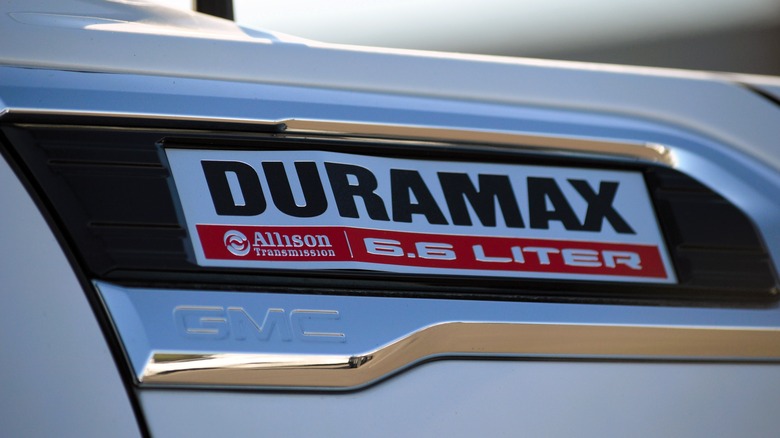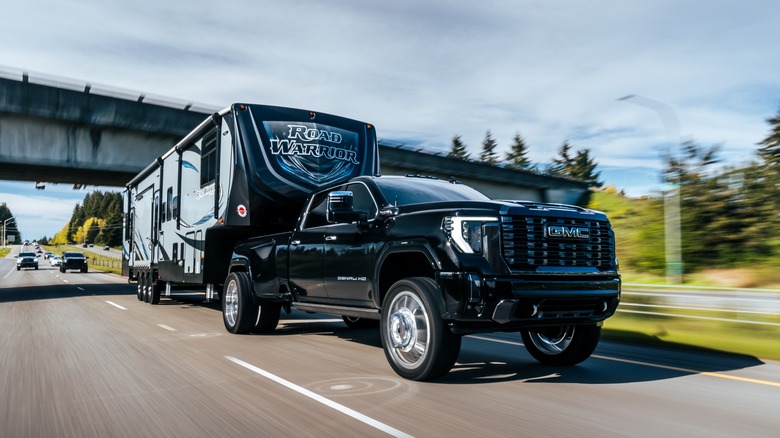
Around the World Photos/Shutterstock
When choosing the right truck for you, what’s under the hood determines many factors. Horsepower, torque, towing capacity, and fuel economy are just a few of the considerations that differentiate one engine from another. Automakers frequently offer several options depending on the truck model, and it can be challenging to see through all the marketing jargon. So, when looking at Chevrolet’s Duramax engine lineup, aside from cubic inches, what sets the 3.0L and 6.6L engines apart? For even more insight, the history behind the legendary Duramax diesel tells an interesting story that spans nearly two decades.
The 3.0L Turbo-Diesel Duramax is available in the Chevy Silverado 1500, the Chevy Tahoe, and the Chevy Suburban. Every 3.0L Duramax is turbocharged, generating 305 horsepower with 495 lb-ft of torque. While not as capable performance-wise as the larger 6.6L Duramax, the 3.0L provides an ideal balance of power and efficiency, helping drivers save fuel.
The 6.6L turbo-diesel Duramax is only available in four truck models. You can equip this behemoth in the GMC Sierra 2500HD, Sierra 3500HD, the Chevy Silverado 2500, and Silverado 3500. The latest 2024 trucks with the 6.6L Duramax can produce 470 horsepower and a monstrous 975 lb-ft of torque. While this larger engine won’t outshine the smaller Duramax in terms of efficiency, it does offer significant performance benefits.
Air intake system and hood scoop

Brandon Woyshnis/Shutterstock
One aspect you likely notice between trucks sporting the 3.0L Duramax versus the larger 6.6L is that the latter features a working air intake. You can see a prominent hood scoop on the Sierra and Silverado HD models that isn’t present on the 1500 or SUVs with the smaller Duramax. It is not just an exterior accessory; this hood scoop helps deliver cooler air to the engine when blistering performance is required.
For example, pulling a trailer is taxing on a truck’s engine, but even more so in the summer, climbing up a steep grade. The air intake on the 6.6L provides additional airflow that keeps the engine running at an optimum level, even in the most demanding situations.
According to GM, upwards of 60% of airflow to the engine originates from the intake system. GM’s intake technology uses a mechanism to split air and water so that only dry air is pushed toward the engine. The lower-temperature dry air helps trucks like the 2024 Sierra 3500HD pull up to 36,000 pounds, even in challenging scenarios. We got behind the wheel of the 2024 GMC Sierra HD AT4X with an equipped 6.6L turbo-diesel Duramax and had some exciting takeaways.
Efficiency and transmission
In terms of fuel economy, the winner hands-down is the 3.0L turbo-diesel Duramax, with up to 29 mpg highway in the Silverado 1500. According to Fuelly, a 6.6L turbo-diesel Duramax-equipped Sierra 3500 only gets a combined 12.45 mpg on average. It’s not just size that factors into the enhanced efficiency of the smaller Duramax, but also a specially shaped combustion chamber and enhanced thermal regulation that includes the ability to increase temperatures within an engine that’s running too cold.
Another difference is that the 3.0L Duramax doesn’t come with the Allison 10-speed automatic transmission. In the world of heavy-duty engines, Allison has a reputation for components that last the test of time if you follow these tips for extending the life of your vehicle’s transmission. After all, Allison manufactures transmissions for vehicles like buses, heavy transporters, freight trucks, and more.
The bottom line is that the 6.6L Duramax is the option for those who need the most power, while the 3.0L Duramax is ideal for drivers who want a balance between performance and fuel economy. For most, the smaller Duramax is the ideal choice, but for the few who absolutely can’t compromise on hauling and pulling capability, the larger Duramax is preferred.